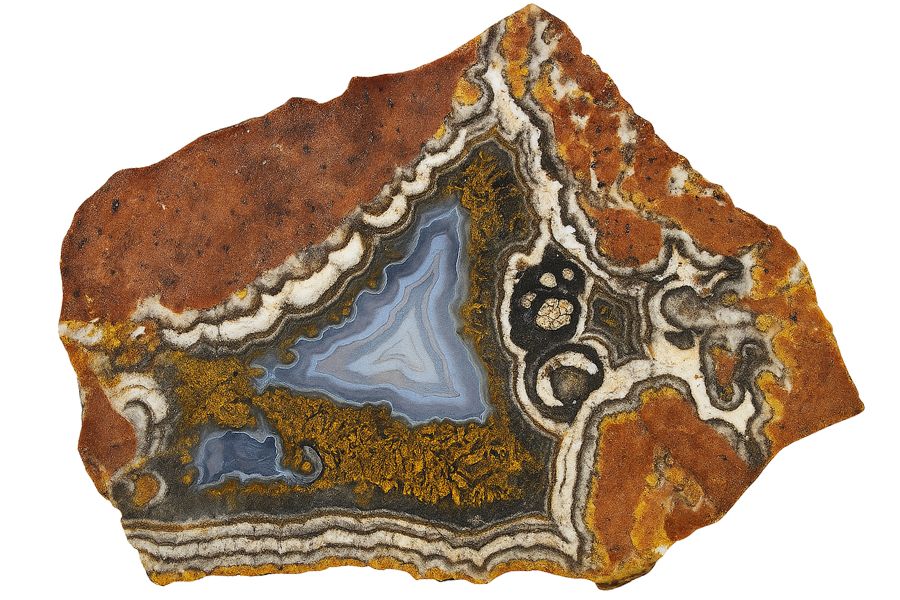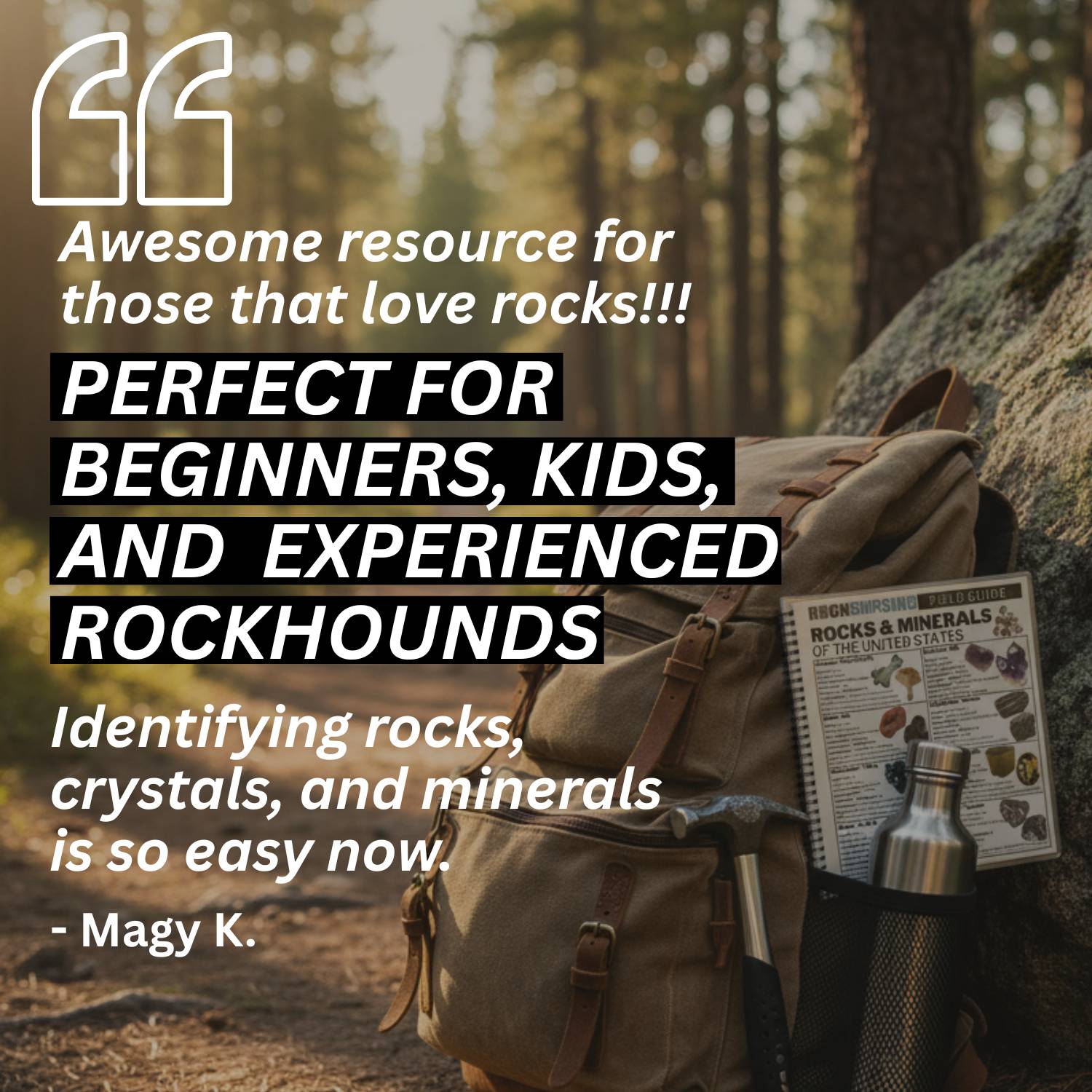Finding agates in New Mexico is a lot of fun with its unique mix of arid land and sudden, intense rainfall creating an ever-changing environment where new stones are brought to the surface. The beautiful desert and mountain landscape is a prime destination for anyone hoping to find agates.
A common and productive method for searching is to explore the sandy stretches of a dry wash after a storm. The water often scours away the loose sand and exposes new pieces that are easily spotted in the bright sun.
Other times, agates can be found hiding in rocky debris or on the open ground where they have been left by centuries of erosion.
This article can help you figure out which areas of New Mexico to try first and what to look for on your journey. By knowing how to read the landscape and where to look closely, you can make your time in the field far more productive and enjoyable.
What is New Mexico Agate?
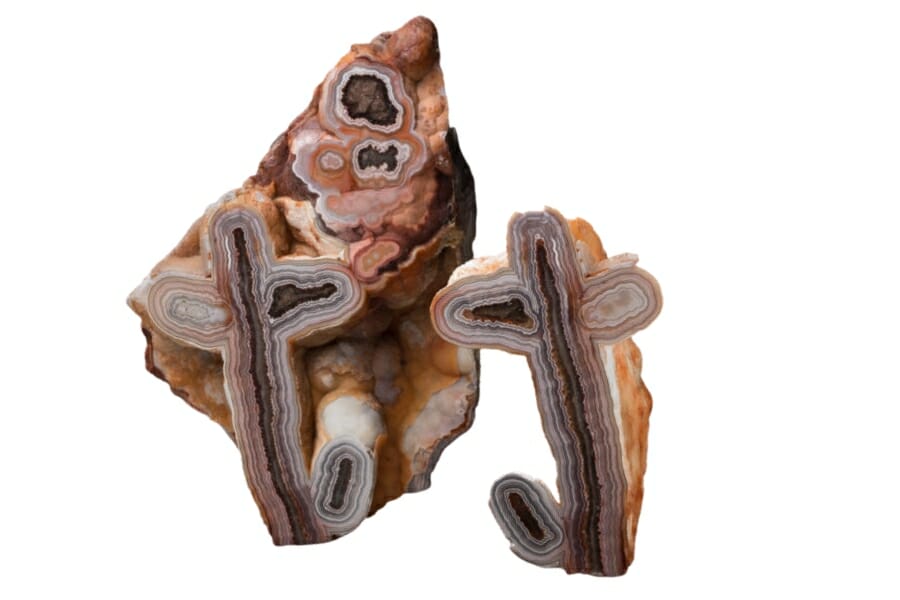
Agate is a chalcedony type, a cryptocrystalline form of silica made up mostly of quartz. It’s known for its fine grain and bright colors. It often comes in bands of different colors that look like the rings of a tree trunk.
These bands can be of various colors, from soft pastels to deep, rich tones. They are caused by the gradual buildup of impurities in the silica gel. Agate can also have spots, patterns, or inclusions of other minerals, which add to its unique and often complicated look.
The stone is clear and has many different patterns that make it a favorite among people who like gemstones and jewelry makers. The different colors and patterns emerge from changes in the mineral content of the groundwater during its formation process.
We’ve created an article about how much agates are worth for more information.
Blue Lace Agate
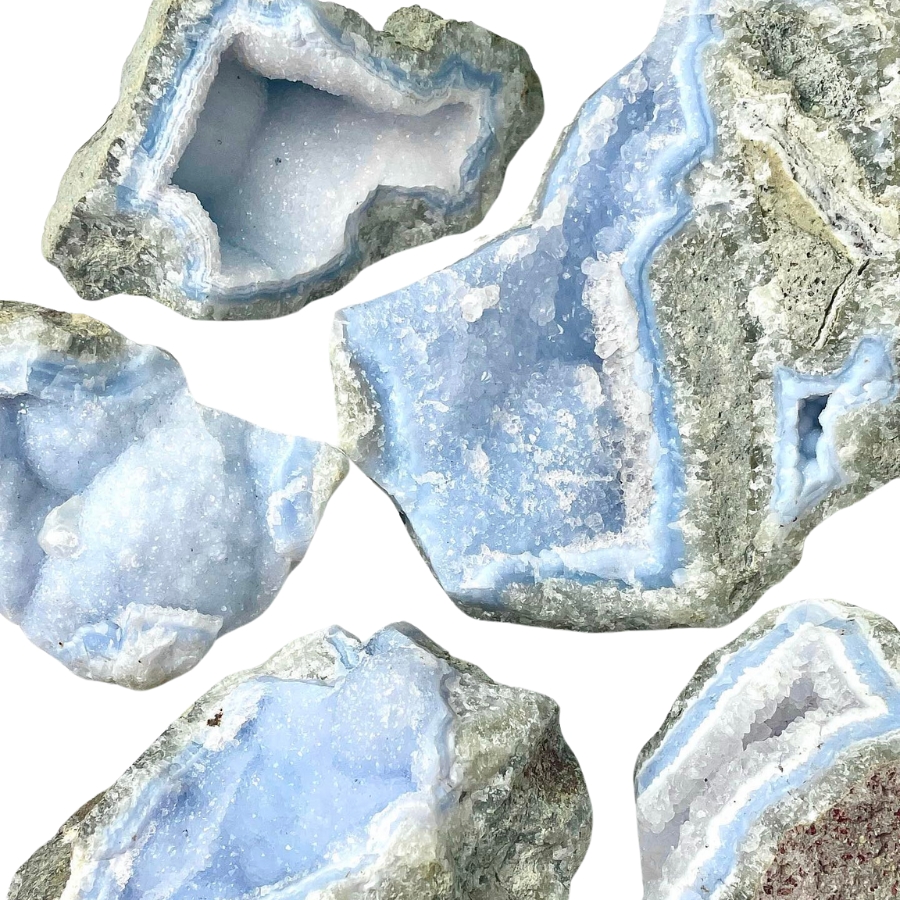
Blue lace agate is like the soft, sky-blue waves with lines that swirl and twist like delicate lace.
Its pattern comes from slow-forming layers of quartz, which create those beautiful, lace-like bands.
The bands of this agate type are often in shades of light blue, white, and sometimes a bit of grey. It’s different from other agates, which usually have more intense colors and stronger patterns.
The value of blue lace agate lies in its soft, tranquil look and the feeling of calm it brings. It’s often used in jewelry or as a decorative stone.
If you want REAL results finding incredible rocks and minerals you need one of these 👇👇👇
Finding the coolest rocks in isn’t luck, it's knowing what to look for. Thousands of your fellow rock hunters are already carrying Rock Chasing field guides. Maybe it's time you joined the community.
Lightweight, mud-proof, and packed with clear photos, it’s become the go-to tool for anyone interested discovering what’s hidden under our red dirt and what they've already found.
Join them, and make your next rockhounding trip actually pay off.
What makes it different:
- 📍 Find and identify 140 incredible crystals, rocks, gemstones, minerals, and geodes across the USA
- 🚙 Field-tested across America's rivers, ranchlands, mountains, and roadcuts
- 📘 Heavy duty laminated pages resist dust, sweat, and water
- 🧠 Zero fluff — just clear visuals and straight-to-the-point info
- ⭐ Rated 4.8★ by real collectors who actually use it in the field
Moss Agate
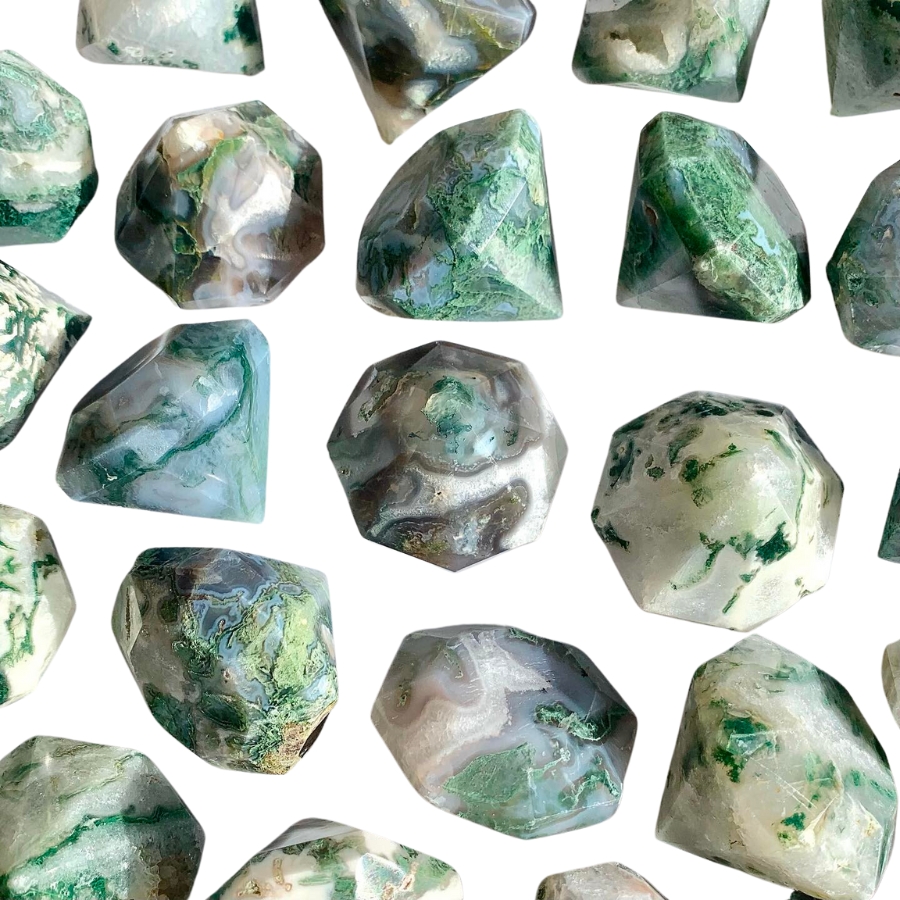
Instead of having the typical banding for which the different types of agates are known, moss agate has green inclusions that look like moss or trees.
These green patterns aren’t real plant material, though. They’re minerals like chlorite or iron oxide.
In some cultures, this type of agate is known as the “gardener’s stone” because of its green, plant-like appearance. It’s believed to help plants grow.
The price of moss agate can vary. It’s often quite affordable, but the more distinct and picturesque the green patterns, the more it might cost.
Fire Agate
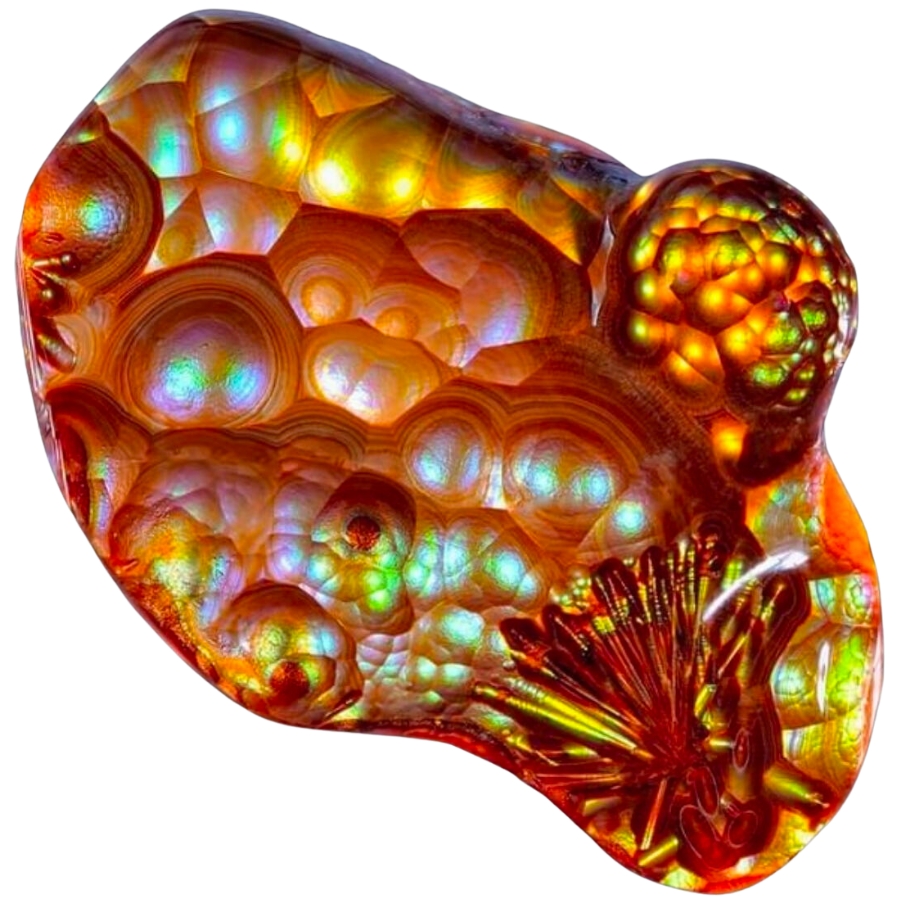
Fire agate is known for its incredible colors and the way it sparkles like fire. It’s got layers of silica and iron oxide that reflect light, creating a fiery effect.
When you look at fire agate, it’s like seeing flames trapped inside. Its colors can range from reds and oranges to greens and golds, all shimmering under the surface.
You might be wondering, “What is fire agate worth?” Well, its value comes from its rare beauty. The more color and sparkle, the more valuable the stone is.
Its fiery iridescence and lively play of color are used in jewelry pieces that are meant to stand out.
Dendritic Agate
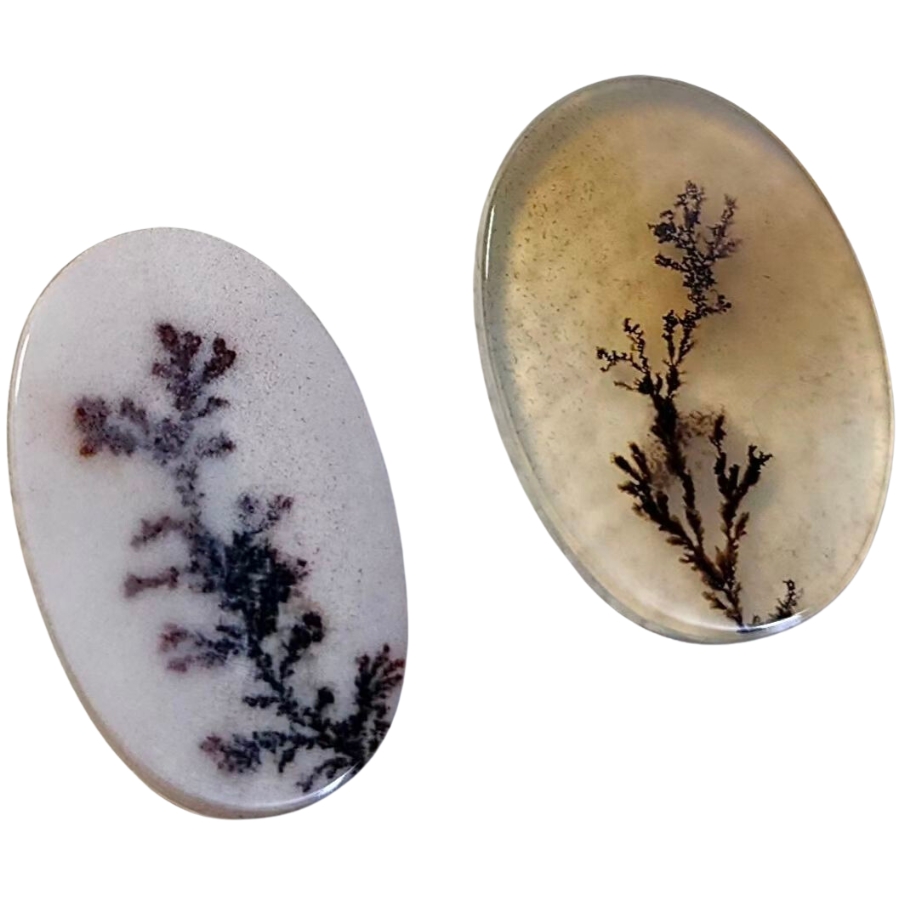
Dendritic agate is known for patterns that look like tiny trees or shrubs. Like moss agate, these patterns aren’t actual plants. They’re made of minerals, mostly manganese or iron oxides.
When you look at a dendritic agate, it’s like peering into a miniature forest or a frosty winter landscape.
The base of the stone is usually translucent to opaque, and the “dendrites”— those tree-like patterns— are often black or brown.
When it comes to how much dendritic agate is worth, it can vary. The more detailed and distinct the patterns are, the more it’s usually valued.
In some cultures, dendritic agate is believed to bring fullness and richness to life.
Crazy Lace Agate
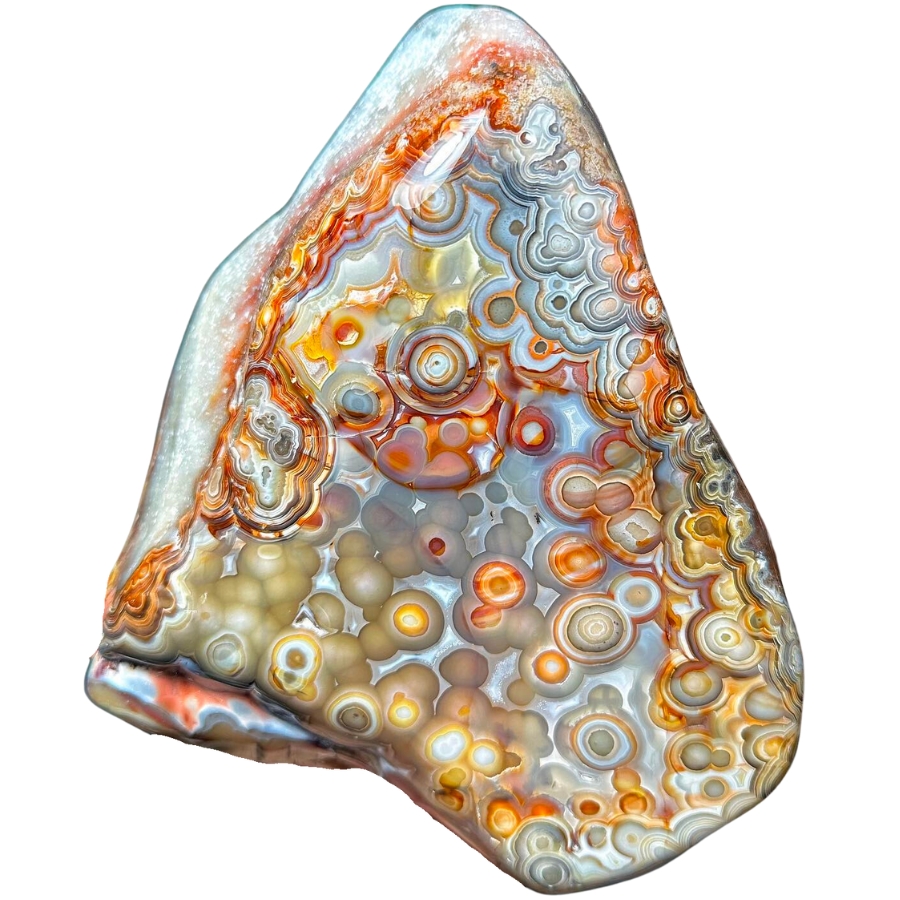
Crazy lace agate is like a party in a rock! It’s got swirls, circles, and all sorts of wild patterns dancing across it.
Its colors can be a mix of red, orange, yellow, and brown, and sometimes even a bit of gray or white.
What makes crazy lace agate stand out is its vibrant and complex patterns. No two pieces are the same. This distinctiveness is a big reason why it’s so valued.
Despite its wild and ‘crazy’ appearance, it’s sometimes called the “Laughter Stone” or “Happy Lace” because of the joy and positive vibes it’s believed to bring.
Laguna Agate
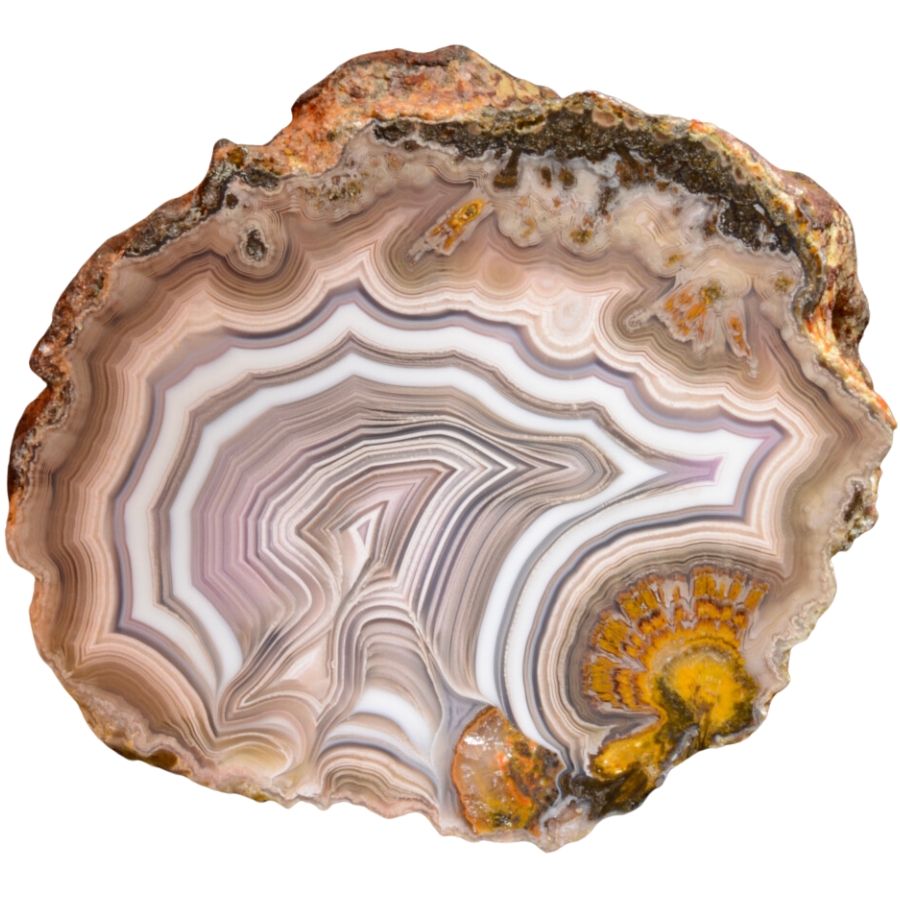
Laguna agate has incredibly sharp and fine banding. It has layers of red, orange, pink, yellow, and sometimes even purple and white all stacked in neat, tight bands.
These bands can form eye-catching patterns, like swirls, loops, and even landscapes.
The different colors of its bands come from various minerals present in the water at the time of its formation.
Laguna agate is considered one of the finest agates in the world due to its exceptional banding. This high regard among agate varieties makes it a prized possession for collectors.
Condor Agate
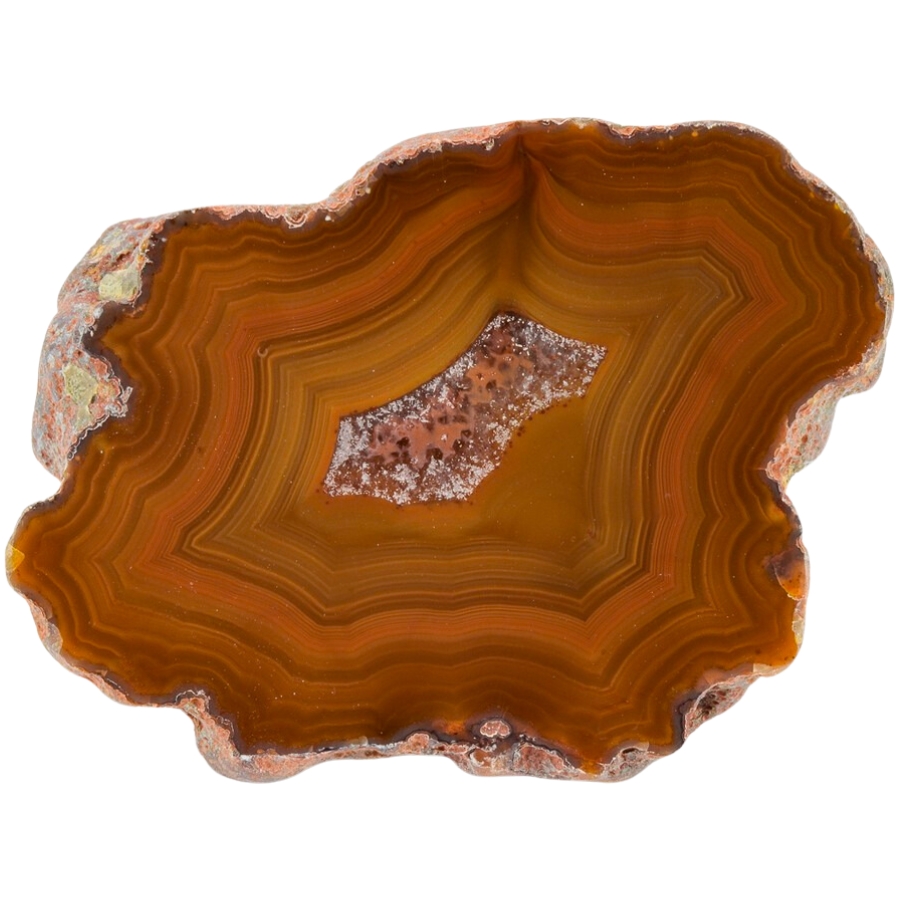
Condor agate is a real standout. It’s known for its bright, vivid colors and complex patterns.
It has reds, oranges, yellows, and sometimes even blues and greens all swirling together. These colors form in bands or in more random, artistic patterns.
The intensity and variety of its colors is what makes condor agate so special. It’s often used by artists and craftsmen who want to make a statement with their work.
Condor agate’s bold colors and patterns can turn a simple piece of jewelry or art into something really eye-catching.
Fortification Agate (Banded Agate)
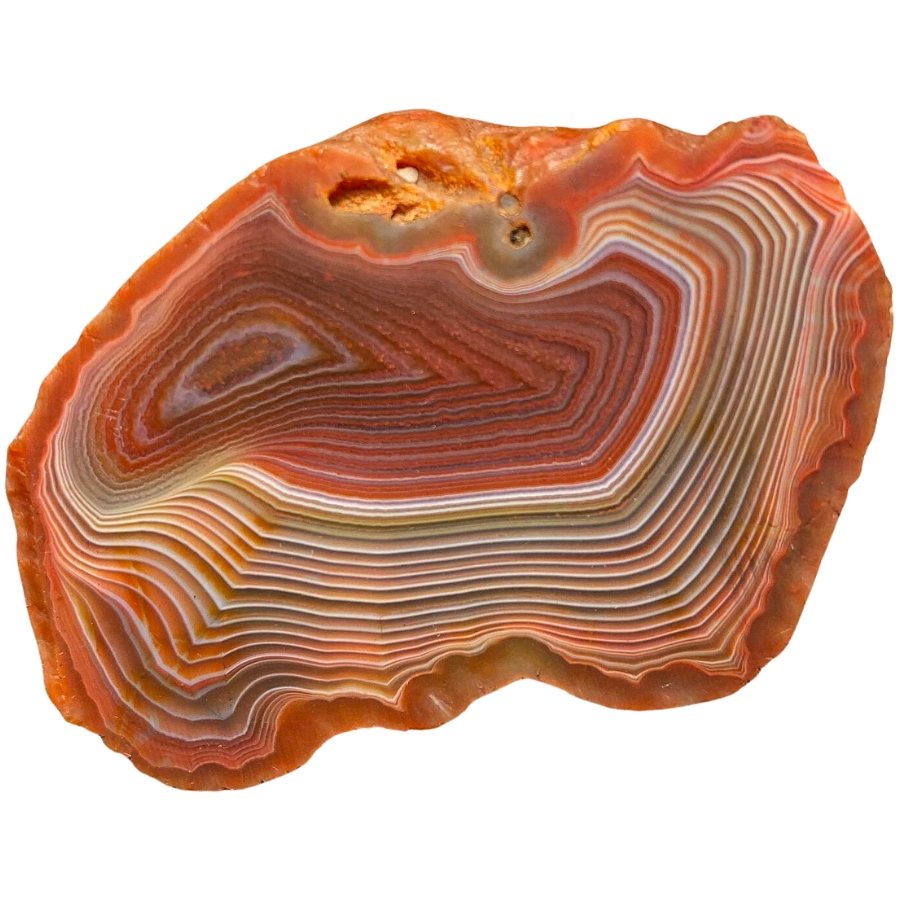
Fortification agate gets its name because the patterns inside it look like the aerial view of a fortified city.
Imagine seeing bands of color forming shapes that look like walls, with sharp angles and curves. They are usually in different colors, making each layer stand out.
If fortification agate is valuable, it’s because of its distinct patterns and colors. Its unique look makes it sought after for jewelry and as a collector’s item.
The clearer and more defined the patterns, the more valuable the stone can be. Some people also believe it can help with relaxation and calmness.
Iris Agate
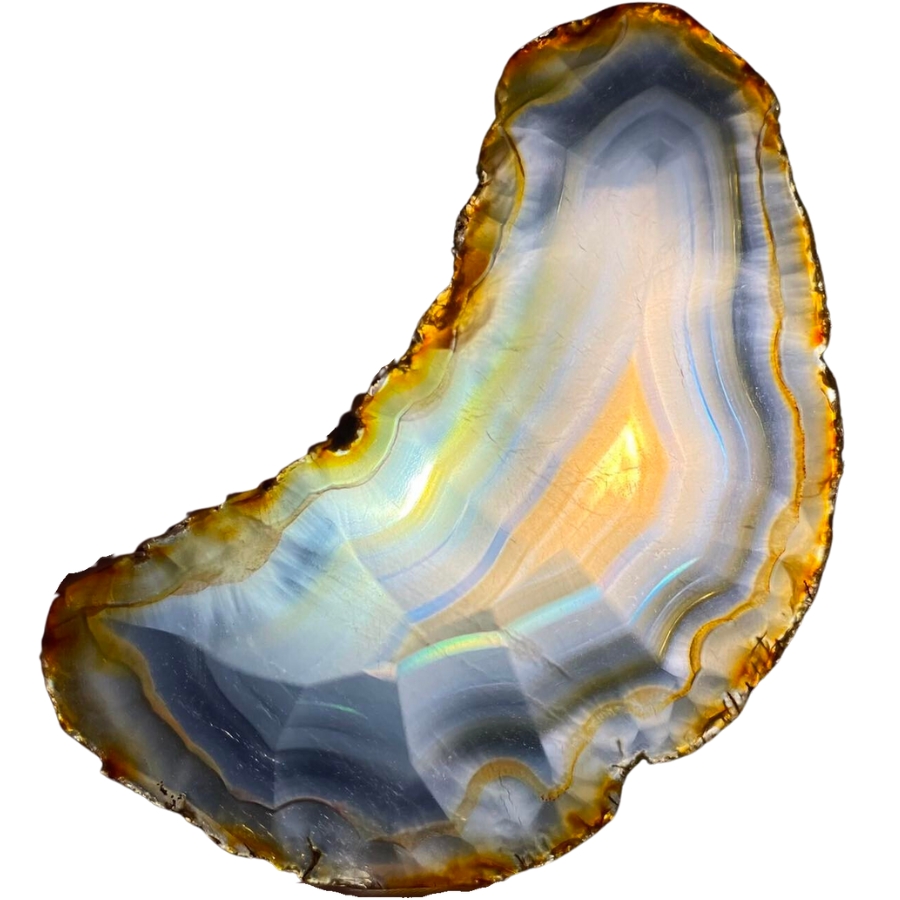
Iris agate looks like a regular agate at first, but when you hold it up to the light, something amazing happens. It shows all these rainbow colors, like light passing through a prism.
This is because it has very thin layers of silica, and when light hits these layers, it splits into all the colors of the rainbow.
The formation of iris agate is similar to other agates, but its layers are super thin, which is what creates the rainbow effect.
The value of iris agate comes from its unique ability to show these colors. In the past, people even used to think it had magical properties because of the way it showed colors. They saw it as a stone of good luck and wonder.
Plume Agate
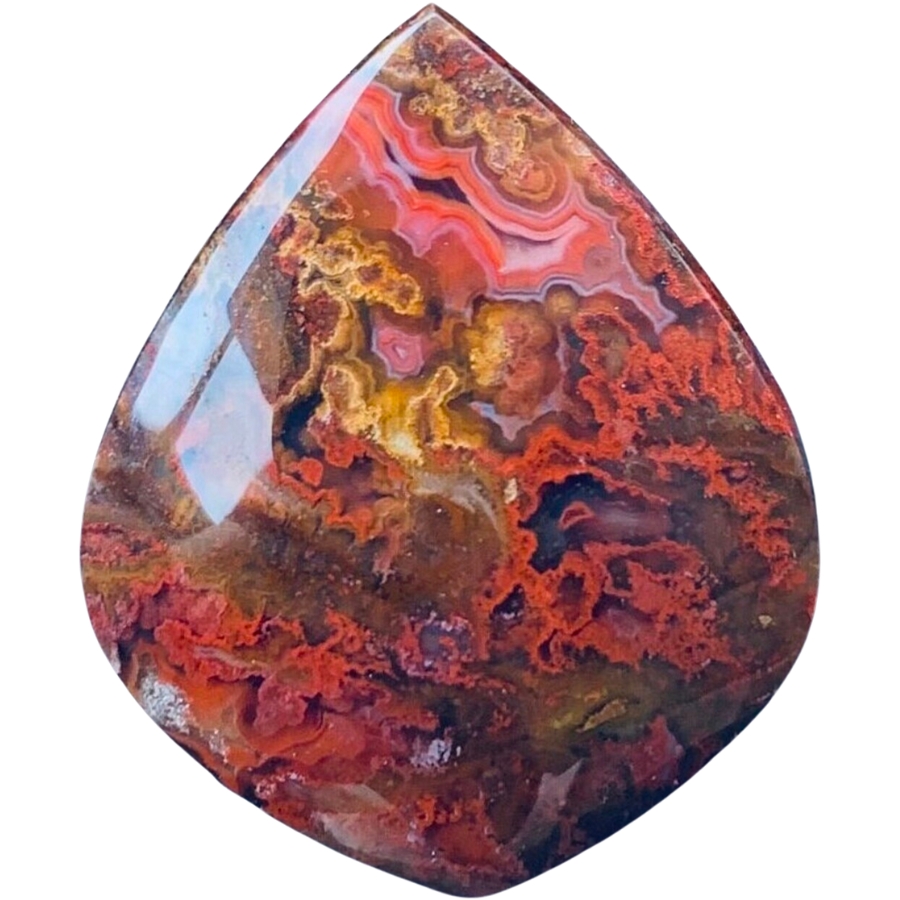
Plume agate gets its name from its patterns that look like soft, feathery plumes. These plumes can be in all sorts of colors: red, black, green, or yellow, set against a translucent or opaque background.
The way these plumes seem to float in the stone makes it look like a frozen underwater scene or like feathers caught in a breeze.
The plumes are made of minerals like manganese or iron oxide, which get trapped in the silica during the agate’s formation and create the feathery patterns.
The price of plume agate can vary depending on how clear and intricate the patterns are. The more detailed and colorful the plumes, the more the stone is usually worth.
Picture Agate (Scenic Agate)
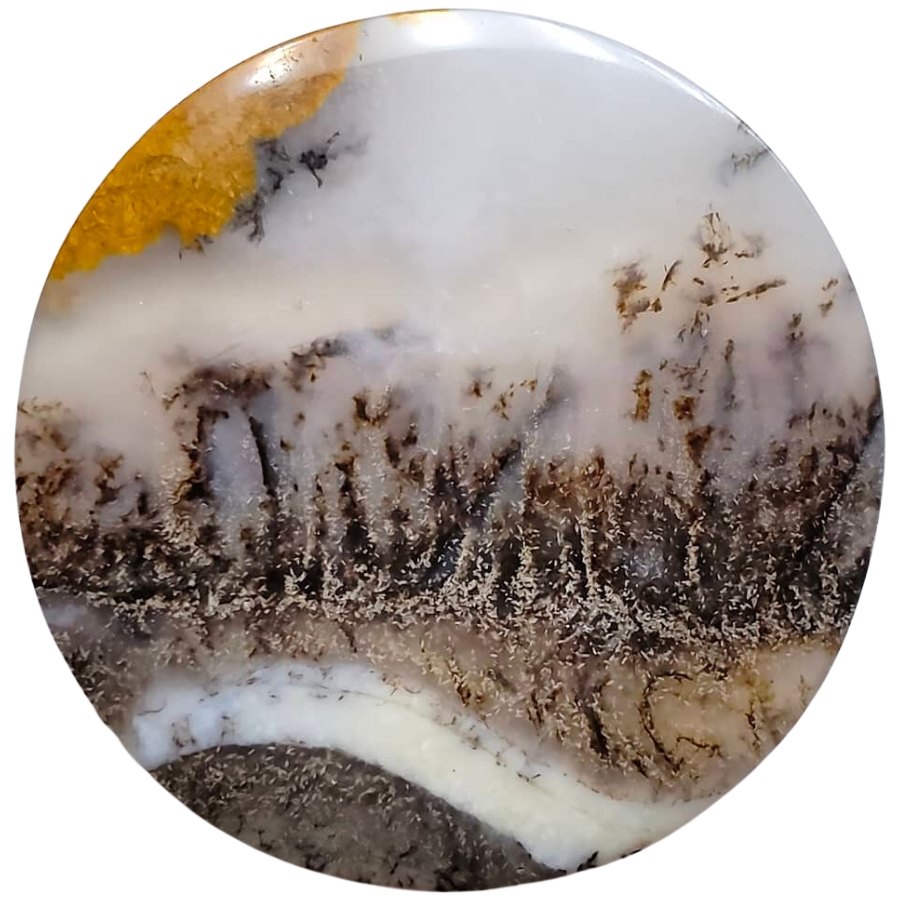
Picture agate is like a snapshot of nature captured in stone because it looks like it has pictures or scenes right inside it.
These “pictures” are actually natural patterns that resemble landscapes, mountains, trees, or even skies. They are usually in different shades of brown, white, and gray against a more translucent background.
The different patterns in picture agate or what’s also called scenic agate are made by various minerals in the water filled with silica that forms it.
If you’re thinking, “What is picture agate worth?“, its value comes from how distinct, clear, and detailed the natural “pictures” are.
Turritella Agate
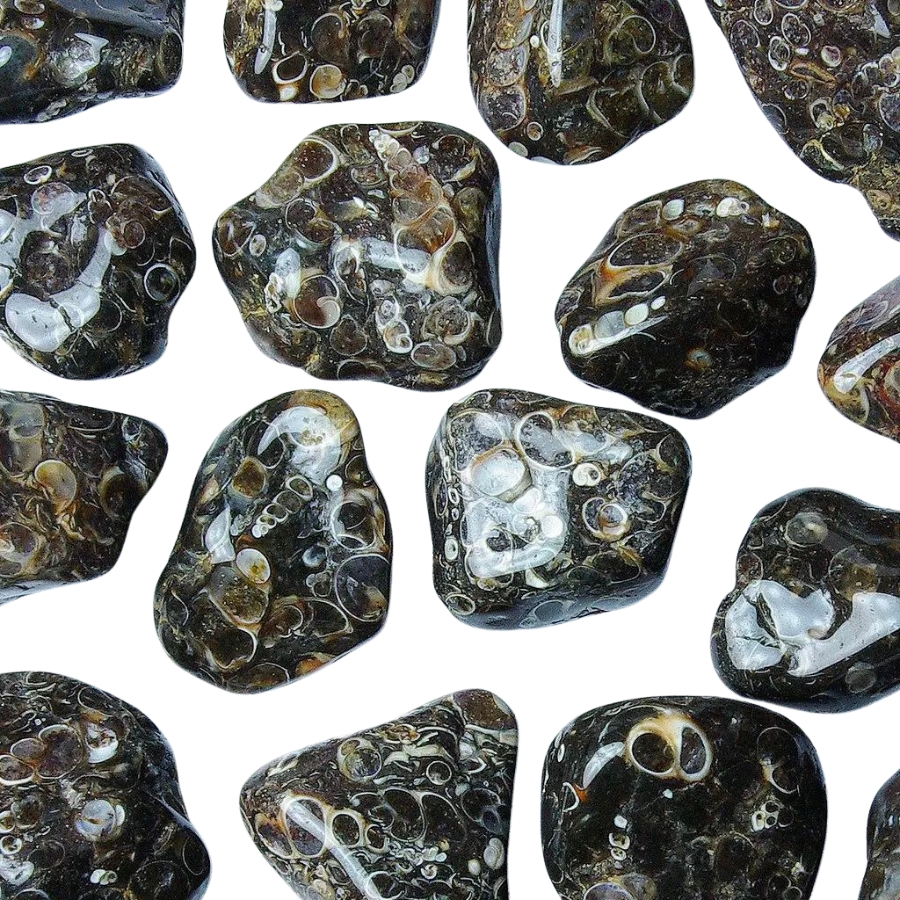
Turritella agate is not your typical agate because it’s full of fossilized snail shells! The shells belong to a creature called Turritella, a type of sea snail.
These shells are tightly packed and create a pattern that looks like a bunch of tiny, swirling towers. The background of the agate is usually a dark, earthy color, which makes the white or cream-colored snail shells really pop.
Over millions of years, these snail shells got buried in sediment and eventually became fossilized. As time went on, silica-rich water flowed through the sediment, turning it into the agate we see today.
The value of turritella agate comes from its unique blend of geology and history. More than a pretty stone, it’s a piece of ancient life preserved in rock.
Fairburn Agate
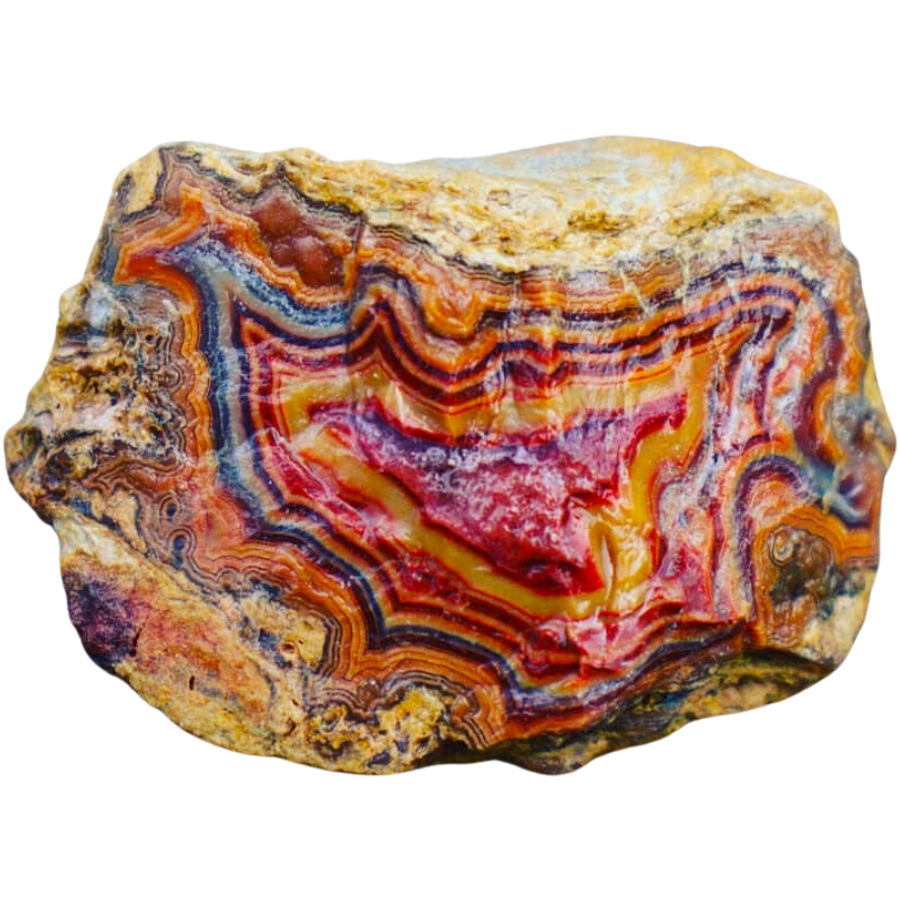
Known for its intricate patterns and bold colors, Fairburn agate is another fascinating type of agate. It usually has bands and swirls of different colors like red, yellow, orange, brown, and sometimes even pink or purple.
What’s special about these patterns is they often look like they’re in layers, creating a 3D effect. It’s like looking at a landscape made of stone.
It’s named after a place called Fairburn in South Dakota. This gives a clue about where it was first discovered.
People value Fairburn agate for the skill it takes to cut and polish it, which makes the patterns and colors really stand out.
Sagenite Agate
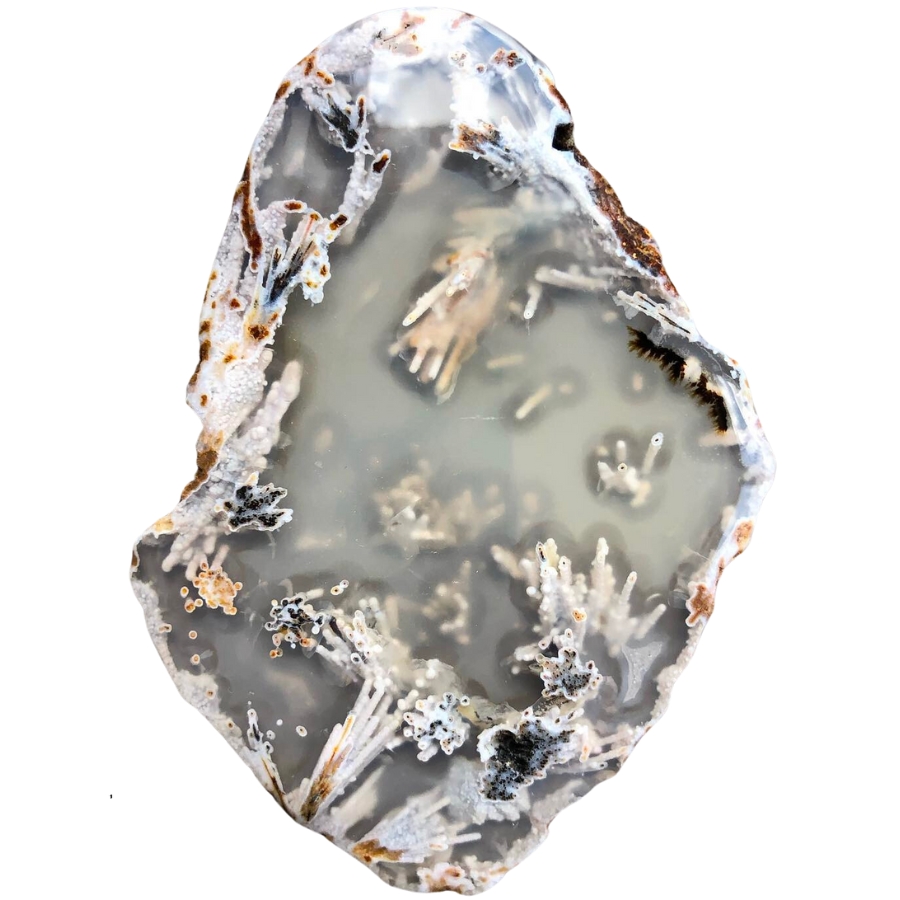
Sagenite agate has needle-like inclusions that look like tiny sprays of crystals inside it. They can be gold, silver, black, or even green, and they spread out in all directions, creating an amazing pattern.
The base of the agate is usually translucent, which lets you see these intricate needle patterns clearly.
These patterns are actually other minerals, like rutile or goethite, that get trapped inside the forming agate. These minerals grow in a crystal shape, looking like needles or hair.
Sagenite agate is often used in jewelry and other decorative items, with some people thinking that its needle patterns look like fireworks or starbursts.
Tree Agate
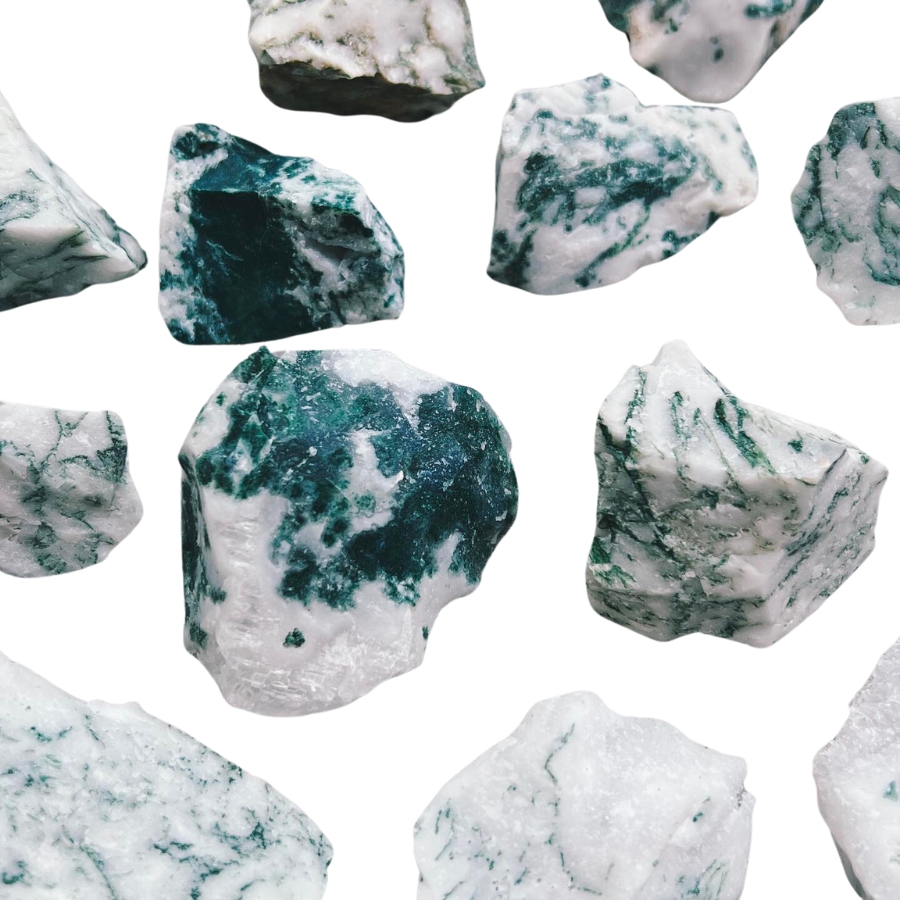
Tree agate, as its name suggests, looks like it’s got tiny trees or branches inside it. These tree-like patterns are usually green and spread out against a white or light gray background.
The green patterns aren’t actual trees, though. They’re made of minerals like chlorite or manganese.
Each piece of tree agate is different. You won’t find two that are exactly the same. It’s valued for its looks and it’s often used in jewelry and decorations.
The key factors in our recommendations are:
- The deep experience and understanding of our team about the area
- Recommendations from local groups and clubs
- How easy it is to get the a particular location
- Safety and potential hazards when collecting
- Weighing private and public locations
- The ability for both experienced and novice agate enthusiasts to find great samples
With these factors in mind we’ve been able to put together a fantastic list that just about anyone can use!
Kids. Beginners. Pros. Doesn’t matter. This book has become the go-to because it works for everyone.
Magy put it bluntly: “Identify rocks, crystals and minerals is so easy now!”
That’s not by accident, the photos are crisp, the callouts are simple, and the design is rugged enough to throw in a backpack without worrying. Whether it’s your first geode or your hundredth, this guide keeps the fun part simple: finding more treasures.
The Best Spots To Find Agates in New Mexico
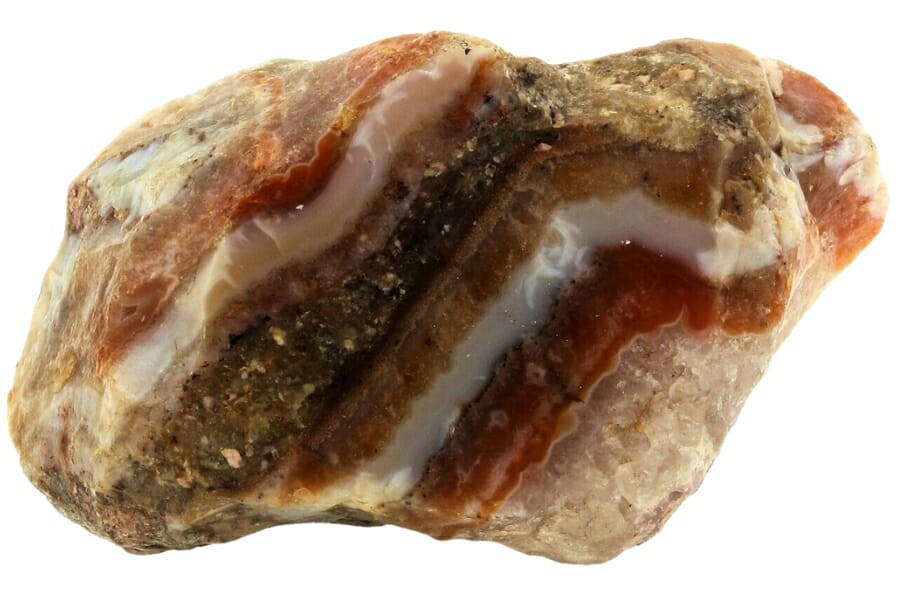
We’ve listed our recommendations in the state where you can find agate specimens. There are also several exciting locations to find gems in New Mexico, but not all contain agates.
Always Confirm Access and Collection Rules!
Before heading out to any of the locations on our list you need to confirm access requirements and collection rules for both public and private locations directly with the location. We haven’t personally verified every location and the access requirements and collection rules often change without notice.
Many of the locations we mention will not allow collecting but are still great places for those who love to find beautiful rocks and minerals in the wild without keeping them. We also can’t guarantee you will find anything in these locations since they are constantly changing.
Always get updated information directly from the source ahead of time to ensure responsible rockhounding. If you want even more current options it’s always a good idea to contact local rock and mineral clubs and groups
Caballo Mountains
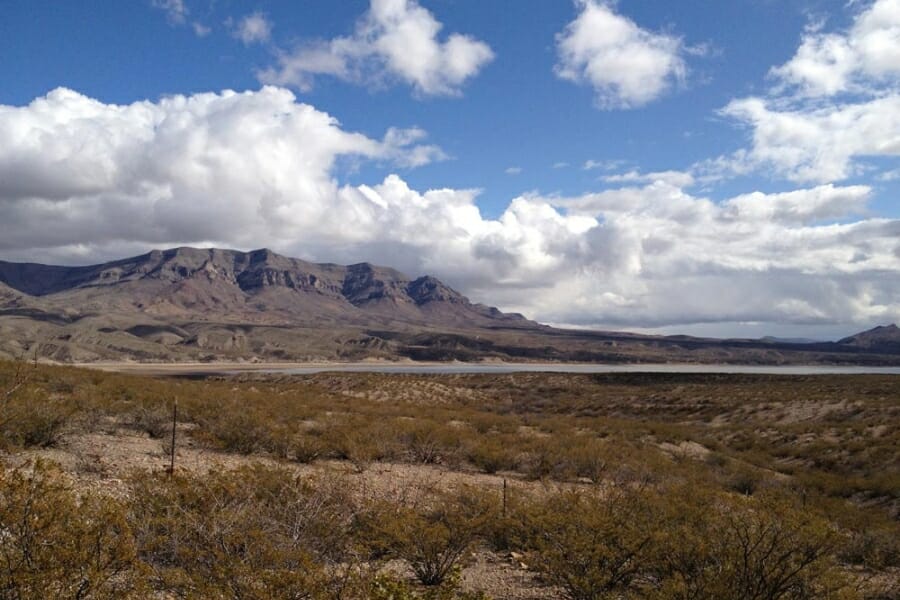
The Caballo Mountains, situated in southern New Mexico, are a striking range that extends roughly north-south for about 23 miles. These mountains are part of the larger Basin and Range Province, reflecting a rich geological history of volcanic activity and subsequent erosion.
The diverse range of mineral formations provides a fertile ground for different agate varieties, each telling a tale of the Earth’s transformative processes for years. Additionally, the presence of chalcedony, a microcrystalline form of quartz, in the vicinity indicates good prospects for locating agate nodules.
Before bringing your agate finds back home from New Mexico, ensure you know the most up-to-date rules about collecting there.
Where we found agates in the Caballo Mountains
Located on the east side of the Caballo Mountains, Red Hill is a site known for its agate deposits. Agates found here are often red or pinkish and may display beautiful banding or other patterns.
Cimarron Canyon State Park
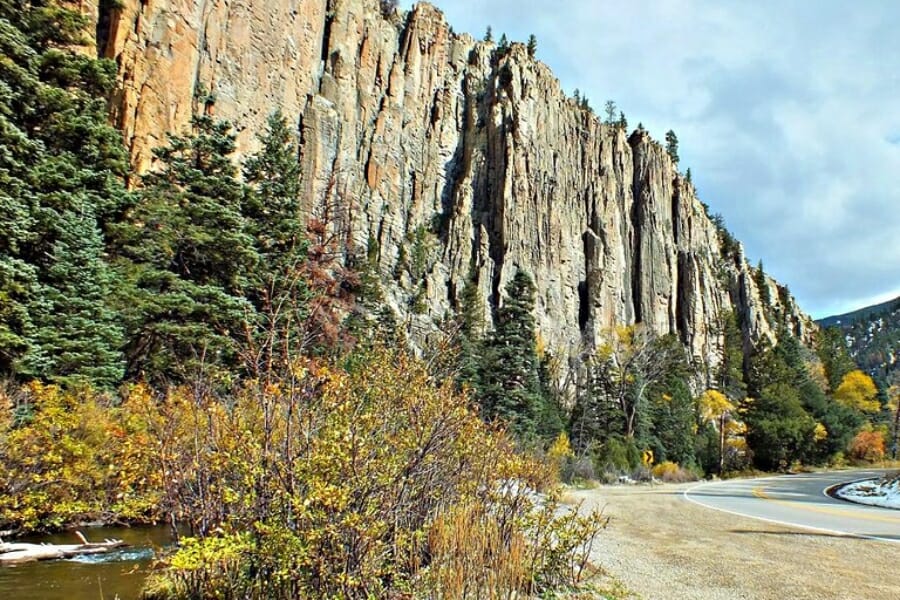
Cimarron Canyon is a stretch of rugged beauty formed by the Cimarron River cutting through the soft volcanic rock of the Sangre de Cristo Mountains. This steep canyon boasts dense forests, cascading streams, and abundant wildlife, making it a haven for nature enthusiasts.
Geologically speaking, Cimarron Canyon’s past volcanic activity and millennia of erosive forces have left a treasure trove of minerals in its wake. The diverse mineral composition in the region implies a good chance of discovering agates with unique patterns and colors.
For those with a keen eye and a bit of persistence, Cimarron Canyon offers a breathtaking backdrop for exploration and the promise of unearthing geological wonders like agates, further enriching the experience of this picturesque location.
Where we found agates in the Cimarron Canyon State Park
The Cimarron River flows through the park and is a logical starting point. Check the exposed and eroded sections of riverbanks, as well as the gravel and pebble beds. The erosive action of the river can uncover agates that have been hidden within the surrounding rock.
Some of the hiking trails within the park also traverse geological formations. The sides of these trails can sometimes reveal rocks and minerals, including agates, especially in areas where erosion or past human activity has exposed the underlying rock.
Hatchet Mountain
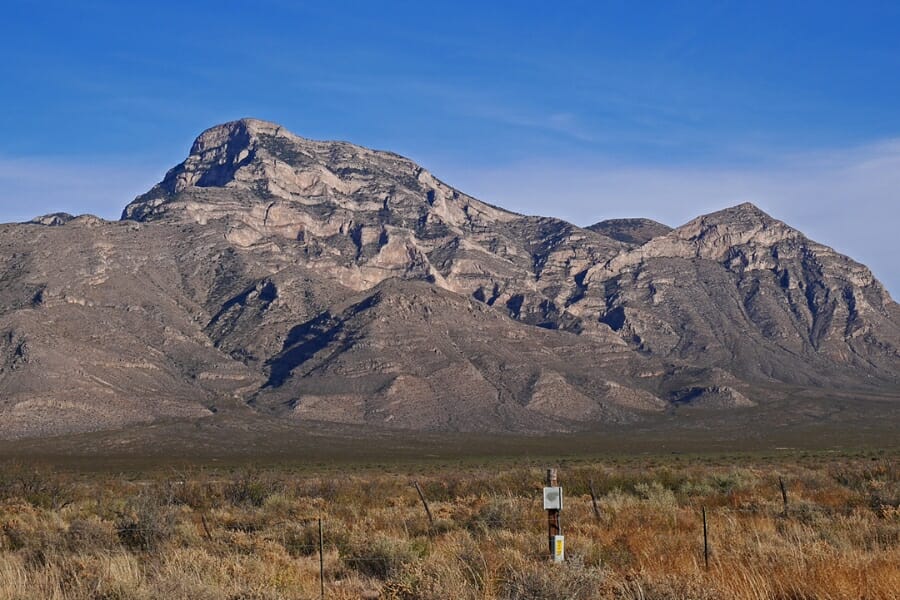
Hatchet Mountain is a testament to the region’s vibrant geological tapestry. With its diverse mineralogical composition, this mountain is a beacon for geologists and rock enthusiasts.
The intricate blend of volcanic and sedimentary rock layers within the mountain suggests a history of varied geological processes, from volcanic eruptions to the sediment accumulation of ancient seas.
Such a mix is often conducive to forming agates; indeed, the mountain offers pockets of these semi-precious stones. The agates here have formed in the cavities of volcanic rocks and have been revealed by millennia of erosion.
Where we found agates in the Hatchet Mountain
Places, where the mountain’s rock has been naturally eroded by wind and rain might expose agates and other minerals.
Nacimieto Mountains
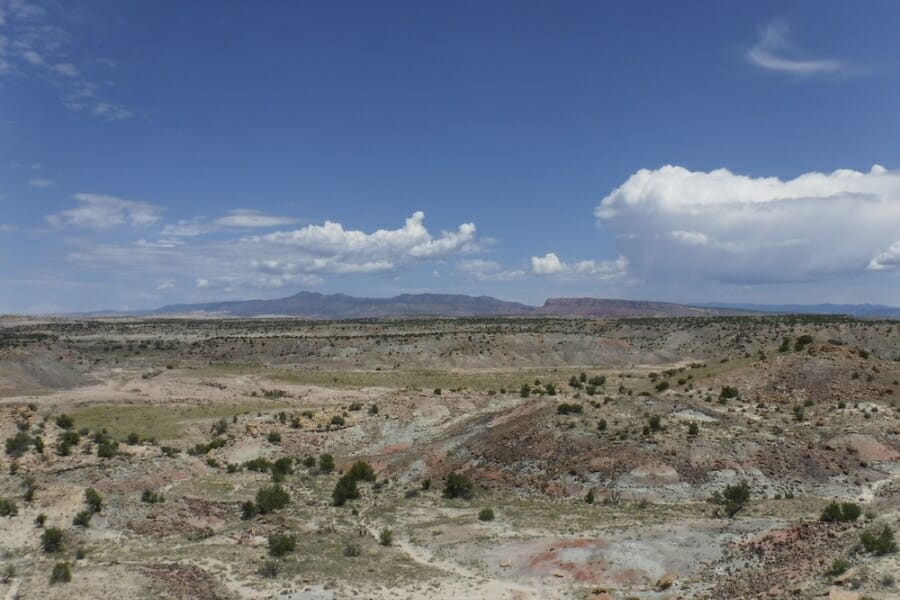
Nacimiento Mountain epitomizes the American Southwest’s geological wonders. Rooted in a complex geological past, this mountain showcases layers of rock that chart a history stretching back millions of years.
The mountain’s unique interplay of volcanic and sedimentary processes makes it a particularly fertile ground for agate hunting. Weathering and erosion have further worked to expose these concealed gems, creating opportunities for discovery.
For rockhounds, the mountain’s charm isn’t just in the promise of finding agates but also in witnessing the dramatic display of Earth’s ever-evolving story. Each banded pattern or color variation within an agate echoes an epoch of geological transformation.
Where we found agates at Nacimiento Mountain
Historically, the Nacimiento Copper Mine, located in the mountain, was an active site. The region around this mine is known to have various minerals, and it’s plausible that agates could be among them.
San Francisco Mountains
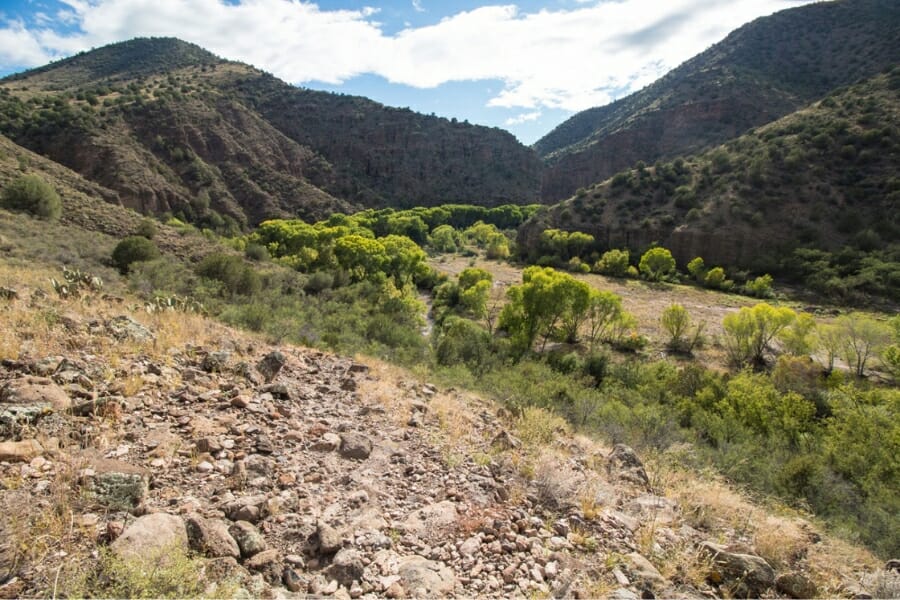
San Francisco Mountain is a monument to the region’s vibrant geological canvas. Composed of a mosaic of rock types, this mountain encapsulates the story of ancient tectonic movements, volcanic eruptions, and the passage of time.
The combination of the mountain’s geology and the erosive forces of the region means that agates can be found in exposed outcrops, dry riverbeds, and other eroded areas where the mineral treasures have been unveiled.
Where we found agates in the San Francisco Mountain
Since agates are often associated with volcanic activity, look for areas where volcanic rocks are exposed. These can sometimes contain cavities filled with agates.
Some trails might also expose agates. Check along trail sides and in exposed rock areas.
Other Great Places To Find Agates in New Mexico
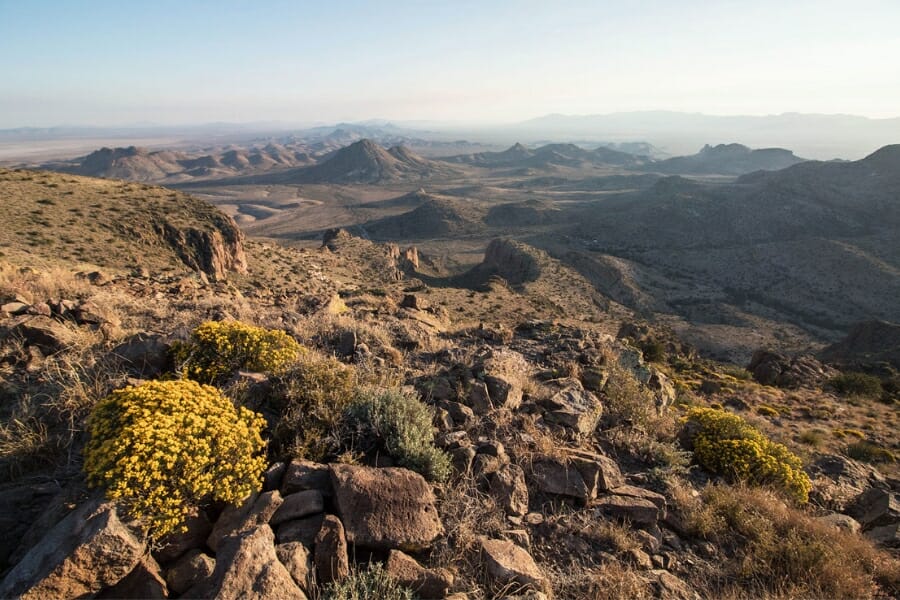
We’ve already given you our best recommendations on where to find agates in New Mexico. Since we want you to be successful in your search and help you further, we’ll suggest more places where you can locate them in the state. We’ve listed them by county below:
Our recommendations by county
| County | Location |
| Bernalilio | Rio Puerto Valley, all area gravels, surfaces, draws, and washes |
| Bernalilio | ALbuquerque area, in banks of arroyos leading towards the river and on adjacent ridges |
| Catron | Lee Russell and Kerr canyons, along way and area surfaces |
| Catron/td> | Turkey Flat gravels and surfaces |
| Catron | Around Elk Horn Park |
| Catron | In the widespread Plains of San Augustine in exposures of volcanic tuffs |
| Catron | Many regional localites in Luna area |
| Grant | Area surrounding Cap Rock Mountain |
| Grant | Alum Peak area surfaces |
| Hidalgo | Peloncillo Mountains |
| Luna | Little Florida Mountains |
| McKinley | Willow Springs |
| Rio Arriba | All area benchlands to Pedernal Peak |
| Sandoval | Regional draws and washes |
| Santa Fe | Mt. Chalchihuitl |
| Sierra | Mud Springs Mountains |
Additional areas you can find agates
Here are some more specific places where you can find agates. We want to help you find these beautiful stones because New Mexico is vast.
Fresh rock exposures
Fresh rock exposures offer an exciting prospect for agate collectors. These newly uncovered areas, whether from natural processes like erosion or human activities such as construction and mining, present a window into the Earth’s hidden geology.
Unlike weathered surfaces, which have been subjected to years of elemental wear, fresh exposures reveal rocks in their more pristine state, often showcasing minerals and gemstones that have remained concealed for millennia.
Streams and creeks
Streams and creeks, with their ceaseless flow and erosive power, stand as dynamic geological agents, constantly reshaping the landscapes they traverse. These waterways serve as natural conveyor belts for agate collectors, unearthing and transporting hidden gems from their origin points to more accessible locales.
As agates form within volcanic rock cavities, the surrounding softer rock gradually erodes, releasing these treasures. Streams and creeks expedite this process, washing away the eroded material and often revealing agates.
Washes and ravines
Washes and ravines, shaped by the intermittent yet powerful forces of water and erosion, offer a unique landscape for agate enthusiasts. As channels, they capture runoff from larger areas, directing water flow and sedimentary cargo through narrowed pathways.
This concentrated movement plays a pivotal role in revealing hidden geologic treasures. As water rushes through, it erodes the softer surrounding rock, potentially unmasking agates that have been encapsulated for ages.
Common Agate-Hunting Questions
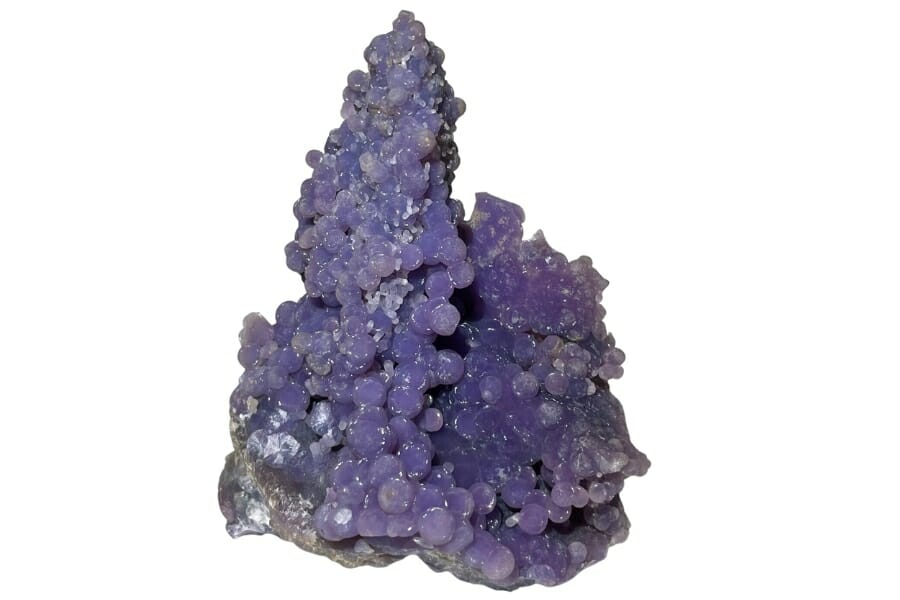
These are the most commonly asked questions when people visit New Mexico to look for agates.
Is it illegal to collect agate in New Mexico?
You can collect agates in New Mexico following all the rules and regulations. When you’re on private land, ensure you have the permission to enter and collect the specimens there.
The Best Places To Buy Agates In New Mexico
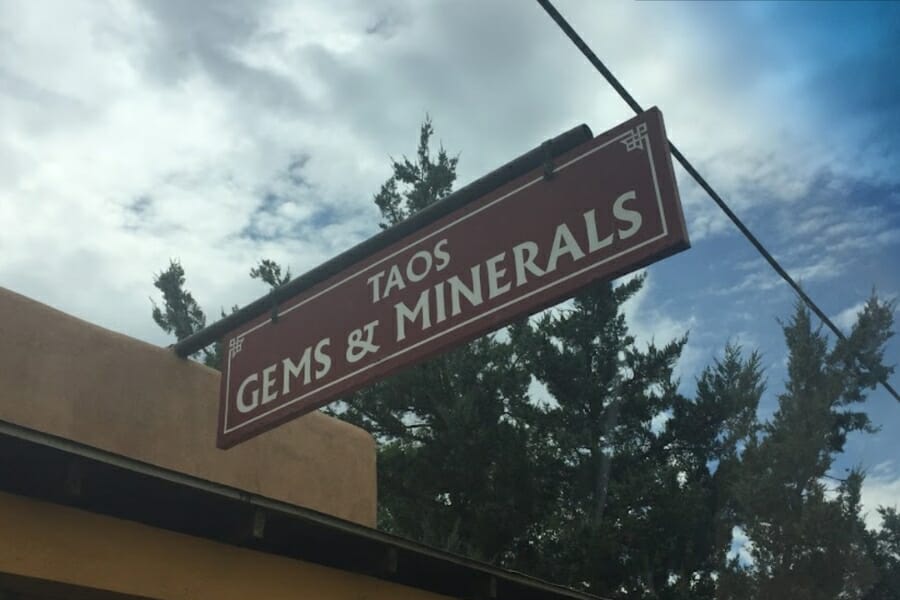
Not everyone likes spending the day outdoors just looking for agates under the heat. Sometimes, you only need one piece to add to your collection or give as a gift. Here are the list of rock shops in New Mexico where you can easily find agate specimens:
- Blanchard Rock Shop – 2972 US-380, Bingham, NM 87832
- New Mexico Rocks – 10000 Coors Bypass NW, Albuquerque, NM 87114
- Spanish Stirrup Rock Shop – 156 Hill Country Rd, Alto, NM 88312
- Taos Gems and Minerals – 637 Paseo Del Pueblo Sur, Taos, NM 87571
- Taos Rockers – 229 Cam De La Placita, Taos, NM 87571
If you have any recommendations for our list please leave a comment below!

